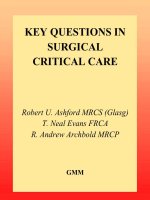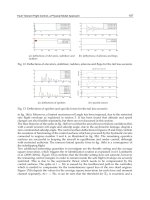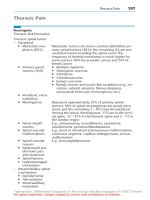KEY QUESTIONS IN SURGICAL CRITICAL CARE - PART 7 doc
Bạn đang xem bản rút gọn của tài liệu. Xem và tải ngay bản đầy đủ của tài liệu tại đây (141.75 KB, 25 trang )
13. A. true B. false C. true D. true E. false
Midazolam is a water soluble benzodiazepine which is used for
sedation as infusion and bolus. It has a relatively short duration
of action as a bolus but cumulates readily when given by infusion
leading to prolonged coma. To prevent this patients should be
assessed frequently and their sedation adjusted. Midazolam is
popular by infusion because it is cheap, water soluble, can be
given in relatively concentrated infusions and is reasonably
familiar to use. One arm-brain circulation time is about
30 seconds and sedatives used for rapid sequence induction
should have their effects within this.
pp 203–205
14. A. true B. true C. true D. false E. false
Despite their similar elimination half lives of about 4 hours,
morphine is longer acting because of the rapid redistribution of
the more lipid soluble fentanyl. Alfentanil has the shortest
duration of action of the commonly used sedatives on ICU.
Fentanyl and Alfentanil infusions can continue for prolonged
periods without precipitating prolonged coma. Morphine has
two active metabolites which can cause prolonged sedation and
apnoea. Morphine causes histamine release and should be used
with care in asthmatic patients.
pp 203–205
15. A. true B. false C. true D. false E. true
All opioids have the tendency to cause chest wall rigidity to
some degree. Fentanyl and the new ultra-short acting opioid
remifentanil seem to be more responsible than the others. All
opioid effects are reversed by naloxone including respiratory
depression, euphoria and nausea. Morphine 3 and 6 sulphate are
both active metabolites and tend to accumulate with prolonged
infusions. This is particularly true in patients with hepatic or renal
failure where fentanyl or alfentanil would be a more sensible
choice. All opioids cause some degree of vasodilatation by a
central action, the amount of accompanying hypotension
depends on the individual drug. Morphine tends to cause more
hypotension than alfentanil or fentanyl.
pp 203–205
SCC
A
SCC
A
SCC
A
Key Questions in Surgical Critical Care
136
MCQs
Principles of Intensive Care
Answers
Kqs-A-s1-5.qxd 5/11/02 11:24 AM Page 136
16. A. true B. false C. false D. false E. true
Rocuronium works within 60 seconds and can be used as an
alternative to suxamethonium for rapid sequence intubation.
Atracurium is an ester which is kept refrigerated because it
undergoes spontaneous breakdown at room temperature,
called Hoffmann degradation which is enzyme independent.
Atracurium is the drug of choice for ICU infusions and in renal
failure since it does not accumulate. Vecuronium is a steroid
which is metabolised in the liver and should be avoided in
hepatic failure because of the risk of accumulation and
prolonged paralysis. Vecuronium has an onset of 2–3 minutes.
pp 203–205
17. A. true B. false C. false D. true E. false
Suxamethonium is a depolarising muscle relaxant which
‘activates’ the neuromuscular junction causing visible faciculation
before temporarily paralysing it. It causes depolarisation because
suxamethonium is structurally related to two acetyl choline
molecules joined together, thereby activating the receptor.
Suxamethonium is metabolised by plasma cholinesterase, an
enzyme produced by the liver which acts locally. Suxamethonium
has a number of side-effects including myalgia in young adults,
hyperkalaemia in burns and spinal injury patients and raised
intra-optic and intra-cranial pressure (these latter two are
temporary). Suxamethonium has rapid onset and offset and is
primarily used for rapid sequence intubation.
pp 203–205
18. A. false B. false C. true D. false E. false
Osmolarity is the concentration of a solution expressed as
osmoles of solute per litre of solution (mosmol/l). Osmolality is
the concentration of a solution expressed as osmoles of solute
per kg solvent (mosmol/kg). Osmolality is independent of
temperature and volume taken up by solutes within the
solutions. Osmolality is the measure most often used clinically,
and is estimated by depression of freezing point. Semipermeable
membranes allow solvent (fluid) but not solute (particles) to pass
through. The osmolality of plasma is 290 mosmol/kg H
2
O.
pp 117–122
SCC
A
SCC
A
SCC
A
Key Questions in Surgical Critical Care
137
MCQs
Principles of Intensive Care Answers
Kqs-A-s1-5.qxd 5/11/02 11:24 AM Page 137
19. A. true B. false C. false D. false E. false
The kidney has a number of metabolic functions including
gluconeogenesis, peptide hydrolysis and arginine formation.
Each kidney is made up of 1.2 million functional units called
nephrons. Most (80%) of cortical nephrons have short loops of
Henle. The juxtamedullary nephrons (20%) have long loops of
Henle which pass into the inner medulla, and are primarily
concerned with the countercurrent exchange mechanism to
establish a concentration gradient within the renal medulla.
Renal blood flow accounts, for about 20% of cardiac output
(625 ml/min to each kidney), this does not change with exercise
and there is autoregulation over a range of blood pressures.
The cortex receives the majority of the renal blood flow, in order
to form an ultrafiltrate.
pp 117–122
20. A. false B. false C. false D. true E. true
Glomerular filtration rate (GFR) is measured using the Fick
principle for the clearance of inulin. Inulin is a polysaccharide of
MW 5500 Daltons which is injected into the body and filtered.
It is not re-absorbed or secreted by the kidney, allowing
measurement of urinary inulin to be used to calculate the
filtration rate. Creatinine clearance is used to give an estimate of
GFR, but since creatinine is secreted to a small degree by the
tubules, it tends to over estimate the value for GFR. Renal plasma
flow is calculated by the clearance of para-amino hippuric acid
(PAH). Renal blood flow is large leading to small differences
between arterial and venous blood in oxygen content. Oxygen
consumption in the cortex is twenty times that in the medulla
due to active transport in the tubules.
pp 117–122
21. A. false B. false C. false D. true E. true
Renin is released from the juxtaglomerula apparatus in the renal
cortex. Renin is a proteolytic enzyme that is released into the
plasma when the body sodium content decreases. Renin also
exists in the brain, heart and adrenal gland. Its substrate is an
␣
2
-globulin, angiotensinogen, liberating an decapeptide
(angiotensin I) and an octapeptide (angiotensin II) via
A
SCC
A
SCC
A
Key Questions in Surgical Critical Care
138
MCQs
Principles of Intensive Care
Answers
Kqs-A-s1-5.qxd 5/11/02 11:24 AM Page 138
a converting enzyme. Angiotensin II acts on the zone
glomerulose of the adrenal cortex to liberate aldosterone.
This in turn acts on the kidney to increase salt and water retention.
Angiotensin II has effects on the cardiovascular, renal and CNS
(causing vasoconstriction) and is broken down in the liver.
pp 117–122
22. A. true B. false C. false D. true E. false
Hypertension can cause a diuresis by increasing medullary blood
flow and reducing the concentration gradient. Carbonic
anhydrase inhibitors e.g. acetozolamide produce a weak diuresis
with high pH, low ammonia and increased bicarbonate loop
diuretics, such as frusemide the Na
ϩ
Cl
Ϫ
co-transport system in
the thick ascending loop of Henle. Amiloride is not an
aldosterone antagonist (spironolactone is an aldosterone
antagonist).
pp 203–205
SCC
A
SCC
Key Questions in Surgical Critical Care
139
MCQs
Principles of Intensive Care Answers
Kqs-A-s1-5.qxd 5/11/02 11:24 AM Page 139
Key Questions in Surgical Critical Care
140
MCQs
1. A. false B. false C. true D. false E. true
Silicone catheters are non-thrombogenic. 10–15% of central
venous pressure (CVP) catheters become colonised. The insertion
point for a subclavian line is at the junction between the medial
1/3 and the lateral 2/3 of the clavicle. The femoral vein lies within
the sheath medial to the artery.
Surgery 2000 18: 2; 56A–C pp 211–217
2. A. true B. true C. true D. true E. false
Indications for intra-cranial pressure (ICP) monitoring are
when clinical signs are obscured (drugs), to assess need for
intervention (head injury, infection), intensive care unit (ICU)
management of head injury and calculation of cerebral perfusion
pressure (CPP)
CPP ϭ mean arterial pressure Ϫ ICP
ICP measurement can be extradural, subdural, subarachnoid or
via a lateral ventricle catheter.
Surgical Critical Care Ashford R, Evans N. GMM Ltd. London, 2001.
pp 225–227
3. A. true B. false C. true D. false E. true
Tracheo-innominate artery erosion (TIAE) carries a mortality when
treated urgently by ligation of the TIA of 75%. The anterior
jugular vein is the vein most likely to cause bleeding problems.
Other complications:
IMMED: haemorrhage, air embolus, local structure damage,
apnoea, misplacement
Continuing care: infection, tracheitis, tracheal
stenosis & necrosis, tube blockage/displacement, surgical
A
SCC
A
SCC
A
Practical
Procedures
Answers
Kqs-A-s1-6.qxd 5/11/02 11:25 AM Page 140
Key Questions in Surgical Critical Care
141
MCQs
Practical Procedures Answers
emphysema, pneumothorax, decannulation problems and
fistulae
Surgical Critical Care Ashford R, Evans N. GMM Ltd. London, 2001.
pp 217–220
4. A. false B. true C. true D. true E. false
The cricothyroid membrane is superior to the cricoid cartilage,
inferior to the thyroid cartilage. Emergency procedures have a
complication rate five times that of elective.
pp 220–221
5. A. true B. true C. true D. true E. true
All the above plus AV fistula, drugs being given in error through
it, and compromise to distal flow as well as infection.
pp 211–217
6. A. true B. false C. false D. false E. false
The internal jugular vein (IJV) is intimately associated with the
carotid artery throughout its course, lying initially posterior to it
and then antero-lateral within the carotid sheath. The IJV is
superficial in the upper part of its course, covered by
sternomastoid muscle in the middle third is again superficial in
the lower third as it splits the sternal and clavicular heads of that
muscle. Cannulation of the middle third requires the operator to
traverse the sternomastoid muscle which can be unpleasant for
the patient when awake. Arrhythmias occur because of guide
wire stimulation of the right atrium and ventricle and is equally
likely if the wire is advanced too far. Electrocardiogram (ECG)
monitoring should always be available for this reason during
central line insertion.
pp 211–214
7. A. false B. false C. false D. false E. true
In patients with cerebral impairment and raised ICP, head
neutral or head down tilt should be limited to the minimum
possible for the procedure. However continuing with head up tilt
A
SCC
A
SCC
A
SCC
A
SCC
Kqs-A-s1-6.qxd 5/11/02 11:25 AM Page 141
risks the development of air embolus, particularly if the patient is
dehydrated and should never be attempted. A low approach to
the IJV reduces the chance of arterial puncture but increases the
incidence of pneumothorax. The subclavian approach should not
be attempted if the patient has a bleeding diathesis since it
cannot be compressed in cases of vessel rupture. The external
jugular vein (EJV) has valves which prohibit the passage of a
guide wire. IJV on the right side is the site of choice but a
catheter placed too far will risk intra-cardiac rupture.
pp 211–214
SCC
Key Questions in Surgical Critical Care
142
MCQs
Practical Procedures
Answers
Kqs-A-s1-6.qxd 5/11/02 11:25 AM Page 142
Section 2 – Vivas
Cardiovascular System – Questions 145
Respiratory System – Questions 147
Other Systems and Multisystem Failure – Questions 149
Problems in Intensive Care – Questions 151
Principles of Intensive Care – Questions 152
Practical Procedures – Questions 153
Cardiovascular System – Answers 155
Respiratory System – Answers 170
Other Systems and Multisystem Failure – Answers 202
Problems in Intensive Care – Answers 223
Principles of Intensive Care – Answers 225
Practical Procedures – Answers 230
Kqs-Q-s2-1.qxd 5/11/02 11:26 AM Page 143
Kqs-Q-s2-1.qxd 5/11/02 11:26 AM Page 144
This page intentionally left blank
1. What clinical features may indicate poor peripheral
perfusion?
2. What complications may arise following thoracic
surgery?
3. What post-operative arrhythmias commonly occur
following cardiac surgery and how would you manage
them?
4. What are the causes of pulseless electrical activity
(PEA)?
5. What are the causes of anaemia in the critically ill patient
and when would you transfuse them?
6. What is Starling’s Law of the heart?
7. What information can be obtained by pulmonary artery
catheterisation in the critically ill patient?
8. What are the indications for pulmonary artery
catheterisation in the critically ill patient?
9. What are the complications of blood transfusion?
10. How would you manage the acute onset of atrial
fibrillation (AF)?
11. How would you treat acute pulmonary oedema?
12. How would you manage the acutely unwell patient with
sudden onset chest pain radiating to the back and an
absent right brachial and radial pulse?
13. Define disseminated intravascular coagulation (DIC).
What are the causes and what haematological results
would you expect in DIC?
Q
Q
Q
Q
Q
Q
Q
Q
Q
Q
Q
Q
Q
Key Questions in Surgical Critical Care
145
Vivas
Cardiovascular
System
Questions
Kqs-Q-s2-1.qxd 5/11/02 11:26 AM Page 145
14. What are the indications for an intra-aortic balloon
pump (IABP)?
15. What are the potential complications of central vein
cannulation?
16. How would you optimise cardiac output in the
hypotensive patient?
Q
Q
Q
Key Questions in Surgical Critical Care
146
Vivas
Cardiovascular System
Questions
Kqs-Q-s2-1.qxd 5/11/02 11:26 AM Page 146
1. How would you interpret a chest radiograph in a critically
ill surgical patient?
2. How would you diagnose adult respiratory distress
syndrome (ARDS) in a ventilator dependent
post-operative surgical patient?
3. How is respiration controlled?
4. What is involved in initiating a breath?
5. How is respiration affected by a) exercise b) general
anaesthesia c) hypovolaemia d) altitude?
6. What is functional residual capacity (FRC) and why is it
important?
7. What is measured using a spirometer?
8. What dynamic tests of respiratory function do you know?
9. What is meant by respiratory compliance?
10. How do ventilation and perfusion vary with spontaneous
and mechanical ventilation? What do you understand by
the terms ‘shunt’ and ‘dead space’?
11. How would you go about interpreting arterial blood gas
(ABG) analysis?
12. How would you classify hypoxia?
13. Which patients are at risk of post-operative hypoxaemia?
What methods are available to deliver oxygen to a
spontaneously breathing patient after surgery?
14. How would you classify respiratory failure, and what are
the signs?
15. What are the indications for intubation and mechanical
ventilation?
Q
Q
Q
Q
Q
Q
Q
Q
Q
Q
Q
Q
Q
Q
Q
Key Questions in Surgical Critical Care
147
Vivas
Respiratory
System
Questions
Kqs-Q-s2-2.qxd 5/11/02 11:27 AM Page 147
16. What are the effects of mechanical ventilation?
17. What modes of mechanical ventilation do you know?
Which of these modes are used for weaning?
18. Why is it important to maintain adequate lung volume?
What methods do you know for optimising lung volume?
19. What factors affect the ability to wean from mechanical
ventilation?
20. What are the causes of airway obstruction? How may
these be managed?
21. What are the principle causes of ARDS? What clinical
findings make up the diagnosis?
22. Describe the pathophysiological processes responsible for
ARDS? What is the prognosis?
23. What are the objectives for respiratory support in a
patient with ARDS? What mechanisms are there to
maintain adequate oxygenation?
Q
Q
Q
Q
Q
Q
Q
Q
Key Questions in Surgical Critical Care
148
Vivas
Respiratory System
Questions
Kqs-Q-s2-2.qxd 5/11/02 11:27 AM Page 148
1. What are the indications for a computed tomography (CT)
scan following a head injury?
2. What type of injuries are possible to blood vessels and
what are their sequelae?
3. What are the causes of raised intracranial pressure (ICP)
after head injury?
4. What are the indications for urgent surgical exploration in
thoracic trauma?
5. How do you decide how much fluid to give a patient with
major burns?
6. How do you diagnose and treat fat embolism syndrome
(FES)?
7. What features of burn injuries would make you suspect an
inhalational injury and how would you manage it?
8. How would you assess the severity of a head injury?
9. What are the causes of massive haemoptysis and how
would you manage a patient with it?
10. How would you manage a patient with acute hepatic
failure (AHF)?
11. What are the clinical features of a raised ICP?
12. How would you manage a patient with a spinal cord
injury?
13. What methods are employed to try to prevent multi-organ
dysfunction syndrome (MODS)?
14. How would you manage a patient with a severe upper
gastrointestinal bleed?
15. How would you manage a patient with blunt chest trauma?
Q
Q
Q
Q
Q
Q
Q
Q
Q
Q
Q
Q
Q
Q
Q
Key Questions in Surgical Critical Care
149
Vivas
Other Systems and
Multisystem Failure
Questions
Kqs-Q-s2-3.qxd 5/11/02 11:29 AM Page 149
16. What is systemic inflammatory response syndrome (SIRS)
and how would you diagnose it?
17. What is MODS?
18. What are the principles of management in MODS?
19. What are the advantages and disadvantages of enteral
nutrition?
20. What are the advantages and disadvantages of parenteral
nutrition?
21. How may nutrition regimens be tailored to patients with
organ dysfunction?
22. What are the daily nutritional requirements of patients
and how may these vary with critical illness?
Q
Q
Q
Q
Q
Q
Q
Key Questions in Surgical Critical Care
150
Vivas
Other Systems and Multisystem Failure
Questions
Kqs-Q-s2-3.qxd 5/11/02 11:29 AM Page 150
1. What are the differences between sepsis, severe sepsis
and septic shock?
2. What are the features of occult intra-abdominal sepsis and
how would you diagnose and treat it?
Q
Q
Key Questions in Surgical Critical Care
151
Vivas
Problems in
Intensive Care
Questions
Kqs-Q-s2-4.qxd 5/11/02 11:30 AM Page 151
Key Questions in Surgical Critical Care
152
Vivas
1. What are the principles for the safe transfer of the
critically ill surgical patient?
2. What are the basics of successful clinical monitoring of
the critically ill patient?
3. What parameters would make you consider early referral
to critical care?
4. What are the principles of analgesia in the multiple
injured patient?
5. What reasons might you want a surgical patient to go to
intensive therapy unit (ITU) electively?
6. What is meant by scoring systems for intensive care unit
(ICU) patients? What scoring systems do you know?
Q
Q
Q
Q
Q
Q
Principles of
Intensive Care
Questions
Kqs-Q-s2-5.qxd 5/11/02 11:31 AM Page 152
1. What are the complications of inserting an intercostal
chest drain?
2. What are the indications for tracheostomy and what are
its advantages?
3. Describe how you would perform a venous cut-down of
the long saphenous vein at the ankle.
4. What are the findings for a diagnostic peritoneal lavage
(DPL) to be positive?
5. Why might you consider monitoring intra-abdominal
pressure (IAP)?
6. What is a chest drain and how does it function?
7. What are the indications and potential complications of
central venous cannulation?
8. Outline the relevant anatomy of a) the internal jugular
vein (IJV) and b) the subclavian vein. Describe the
technique used to cannulate each of these central veins.
Q
Q
Q
Q
Q
Q
Q
Q
Key Questions in Surgical Critical Care
153
Vivas
Practical
Procedures
Questions
Kqs-Q-s2-6.qxd 5/11/02 11:32 AM Page 153
Kqs-Q-s2-6.qxd 5/11/02 11:32 AM Page 154
This page intentionally left blank
Key Questions in Surgical Critical Care
155
Vivas
1. What clinical features may indicate poor peripheral
perfusion?
1. Classically poor peripheral perfusion is indicated by cool clammy
skin with poor capillary filling and collapsed veins. Other
indicators are confusion, decreased peripheral temperature,
oliguria or anuria, metabolic acidosis, a low volume pulse and
peripheral cyanosis.
pp 15–20
2. What complications may arise following thoracic surgery?
2. Intrathoracic bleeding
Usually occurs from lung parenchyma or bronchial vessels and
may present with clinical features of hypovolaemia. It is usually
detectable from drains. Re-operation is required if there is rapid
blood loss via chest drain, a significant intrapleural collection on
chest X-ray, persisting hypovolaemia despite transfusion or
hypoxia due to compression of the underlying lung.
Sputum retention and atelectasis
Presents as tachypnoea and hypoxia. Examination usually shows
reduced bilateral basal air entry. Prevention is preferred to
treatment. The mainstay of treatment is chest physiotherapy, but
tracheostomy and suction may be required. Antibiotics are
reserved for those with proven pneumonia.
Air leak
These presents as a persist air leak or bubbling of chest drain and
usually settle spontaneously over 2–3 days. They may require
suction on pleural drains. Apposition of lung to parietal pleura
encourages efficient healing.
Bronchopleural fistula
Fistulae are seen in 2% of patients undergoing pneumonectomy.
They usually occur as a result form a leak from a suture line, and
A
Q
SCC
A
Q
Cardiovascular
System
Answers
Kqs-A-s2-1.qxd 5/11/02 11:26 AM Page 155
Key Questions in Surgical Critical Care
156
Vivas
Cardiovascular System
Answers
occurs particularly in those with factors impairing wound
healing. They most commonly occur 7–10 days after surgery
presenting with sudden breathlessness and expectoration of
bloodstained fluid. Treatment is to lie the patient with operated
side downwards, oxygen and chest drain, thoracotomy and
repair of fistula may also be required.
pp 49–55
3. What post-operative arrhythmias commonly occur
following cardiac surgery and how would you manage
them?
3. Atrial tachyarrhythmias occur with an incidence of between
17 and 33%, and generally occur between days 2 and 3. Atrial
fibrillation (AF) is the most common, is usually symptomatic but
often self-limiting. It may cause haemodynamic compromise or
thromboembolic events. The treatment depends on
haemodynamics. For the haemodynamically stable a -blocker is
indicated, for the haemodynamically unstable, DC cardioversion
is employed first then rate control drugs (metoprolol, digoxin,
verapamil).
Sustained ventricular tachyarrhythmias are uncommon after
surgery (0.4–1.4%). These arrhythmias are associated with
haemodynamic instability, electrolyte disturbances, hypoxia and
graft occlusion. These are associated with poorer short and long
term prognosis with a hospital mortality of upto 50%. Acute
treatment may require lidocaine or amiodarone. Ventricular
tachycardia may progress to ventricular fibrillation requiring
defibrillation. Isolated premature ventricular complexes are not
uncommon, often associated with electrolyte imbalance and do
not require acute treatment.
p 51
4. What are the causes of pulseless electrical activity
(PEA)?
4. Pulseless electrical activity (PEA) was known as electromechanical
dissociation (EMD). It is the presence of an electrical cardiac
rhythm in the absence of a cardiac output. Causes are divided
into primary and secondary (Table 1.1)
A
Q
SCC
A
Q
SCC
Kqs-A-s2-1.qxd 5/11/02 11:26 AM Page 156
Key Questions in Surgical Critical Care
157
Vivas
Cardiovascular System Answers
Table 1.1 Primary and secondary causes of PEA
Primary PEA Secondary PEA
Myocardial infarction Tension pneumothorax
Drugs Hypovolaemic shock
-blockers Cardiac tamponade
Calcium antagonists Pulmonary embolus
Electrolyte imbalance Cardiac rupture
Hyperkalaemia
Hypocalcaemia
pp 11–15
5. What are the causes of anaemia in the critically ill patient
and when would you transfuse them?
5. Anaemia can be due to bleeding (occult or overt), anaemia of
critical illness, or in the very young due to repeated blood
sampling. Occult bleeding can be into the skull, thorax, abdomen,
retroperitoneal space, pelvis, limbs for closed long bone fractures
or at the scene of an accident. Anaemia of critical illness is due to
bone marrow suppression, decreased erythropoetin production or
an impaired bone marrow response to erythropoetin.
Transfusion is necessary when there is evidence of impaired
perfusion. There is no single transfusion trigger figure but the
following give an idea when transfusion is necessary: haemoglobin,
haematocrit, ongoing haemorrhage, symptomatic anaemia,
perfusion impairments and impaired oxygenation. A lower
threshold for transfusion is necessary with extremes of age.
pp 36–41
6. What is Starling’s Law of the heart?
6. Starling’s Law describes the relationship between preload or
filling pressure and stroke volume. The force of myocardial
muscle contraction is proportional to the amount of stretch in
the cardiac muscle fibres prior to contraction. Thus, in the normal
heart stroke, volume increases as the end-diastolic volume
increases (Fig. 1.1). The ventricular function curve is displaced
upwards (increased contractility) by sympathetic activation
including positive inotropes (e.g. dobutamine, adrenaline) and
displaced downwards (decreased contractility) by hypoxia,
A
Q
SCC
A
Q
SCC
Kqs-A-s2-1.qxd 5/11/02 11:26 AM Page 157
Key Questions in Surgical Critical Care
158
Vivas
Cardiovascular System
Answers
acidosis and negatively inotropic drugs (e.g. -blockers and
calcium antagonists).
The relationship between preload and stroke volume persists in
the failing heart. Indeed, it acts as one of the compensatory
mechanisms in heart failure that initially maintains stroke
volume. A reduced stroke volume results in an increased amount
of blood in the ventricle at end-diastole. The amount of stretch
within the ventricular muscle fibres is therefore increased and
through Starling’s Law, myocardial contractility is increased,
restoring stroke volume.
In the failing heart, however, the left ventricular function curve is
flattened (Fig. 1.1) such that increasing left atrial filling pressure,
the preload of the left ventricle, (above about 20 mmHg) does
not produce a further increase in stroke volume, but does
predispose to the development of pulmonary venous
hypertension and pulmonary oedema.
pp 3–4
7. What information can be obtained by pulmonary artery
catheterisation in the critically ill patient?
7. During catheterisation of the right heart and pulmonary artery,
pressures are transduced directly from the catheter tip through
A
Q
SCC
Fig. 1.1 Ventricular function curves demonstrating the relationship
between stroke volume and preload in the normal, failing and
stimulated heart.
Stroke
volume
Filling Pressure (Pre-load)
Failing heart
Normal heart
Sympathetic activation
Kqs-A-s2-1.qxd 5/11/02 11:26 AM Page 158
Key Questions in Surgical Critical Care
159
Vivas
Cardiovascular System Answers
the fluid-filled lumen: central venous pressure (CVP), right
ventricular pressure, pulmonary artery pressure, pulmonary
artery occlusion pressure (PAOP). Blood can be aspirated from
the distal port or the right atrial port of the catheter to measure
blood oxygen saturations from the right heart and pulmonary
artery. Cardiac output and systemic vascular resistance (SVR) can
be estimated indirectly from information gained during right
heart catheterisation.
The CVP and the PAOP provide an objective measure of the
filling pressure or preload of the right and left ventricles,
respectively. Right ventricular and pulmonary artery pressure
indicate whether or not pulmonary hypertension is present.
A ‘step-up’ in blood oxygen saturations between the right atrium
and right ventricle indicates that oxygenated blood is entering
the right ventricle (a left to right shunt) and is consistent with
a ventricular septal defect (VSD), which may occur acutely after
myocardial infarction.
Cardiac output is estimated by thermodilution. A known volume
(typically 10 ml) of cold crystalloid is injected into the right atrial
port of the pulmonary artery catheter. A thermistor at the
catheter tip measures the resultant transient temperature
decrease in the pulmonary artery. The area under the curve
when fall in temperature is plotted against time correlates with
cardiac output, which is calculated by computer.
SVR can be calculated from aortic pressure, right atrial pressure
and cardiac output.
pp 18–20
8. What are the indications for pulmonary artery
catheterisation in the critically ill patient?
8. The indications for pulmonary artery catheterisation can be
broadly divided into scenarios requiring measurement of the
PAOP, cardiac output and SVR, and blood oxygen saturations
(see Question 2 in this section and Table 1.2).
A
Q
SCC
−
=
80 (mean aortic pressure mean right atrial pressur
e)
S
VR
cardiac output
Kqs-A-s2-1.qxd 5/11/02 11:26 AM Page 159
Key Questions in Surgical Critical Care
160
Vivas
Cardiovascular System
Answers
Table 1.2 Indications for pulmonary artery catheterisation
Measurement of PAOP to determine volume status and optimise
cardiac output:
Oliguria
Hypotension
RV infarction
Cardiogenic shock
Septic shock
Adult respiratory distress syndrome (ARDS)
Measurement of cardiac output/SVR to guide inotropic therapy:
Cardiogenic shock
Septic shock
Measurement of right heart blood O
2
saturations:
Diagnosis of left to right shunt (VSD)
Mixed venous (PA) O
2
concentration needed for some measures of
cardiac output
PAOP
The accurate assessment of volume status is central to the
appropriate management of the critically ill patient.
Measurement of the PAOP is therefore indicated when volume
status remains uncertain after clinical evaluation. Clinical
assessment of volume status may be particularly difficult in the
presence of chronic lung disease and tricuspid regurgitation.
Furthermore, if there is a disparity between the function of the
right and left ventricle (right ventricular infarction, pulmonary
embolism, cor pulmonale, left ventricular disease), the filling
pressure of the right heart (CVP) may not reflect the filling
pressure of the left heart. In these circumstances, the CVP will
not be an accurate guide to volume status and measurement of
the PAOP is indicated.
A normal PAOP is about 8–12 mmHg. A low value implies
hypovolaemia. Pulmonary oedema in the presence of a low
PAOP indicates ARDS. An elevated PAOP implies volume
overload.
In addition to its diagnostic purpose, PAOP can also be used to
guide fluid administration in patients who are at risk of
developing volume overload such as the elderly or those with
a history of heart disease.
Kqs-A-s2-1.qxd 5/11/02 11:26 AM Page 160









